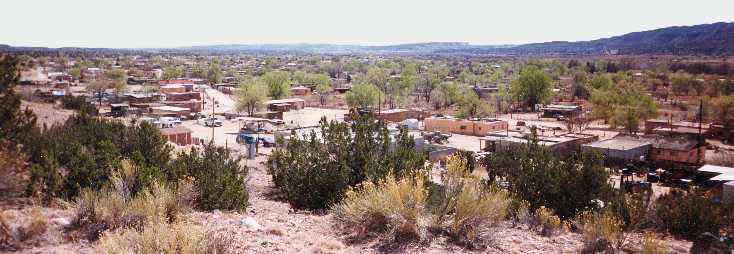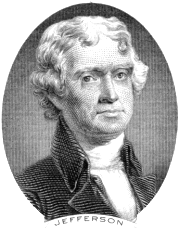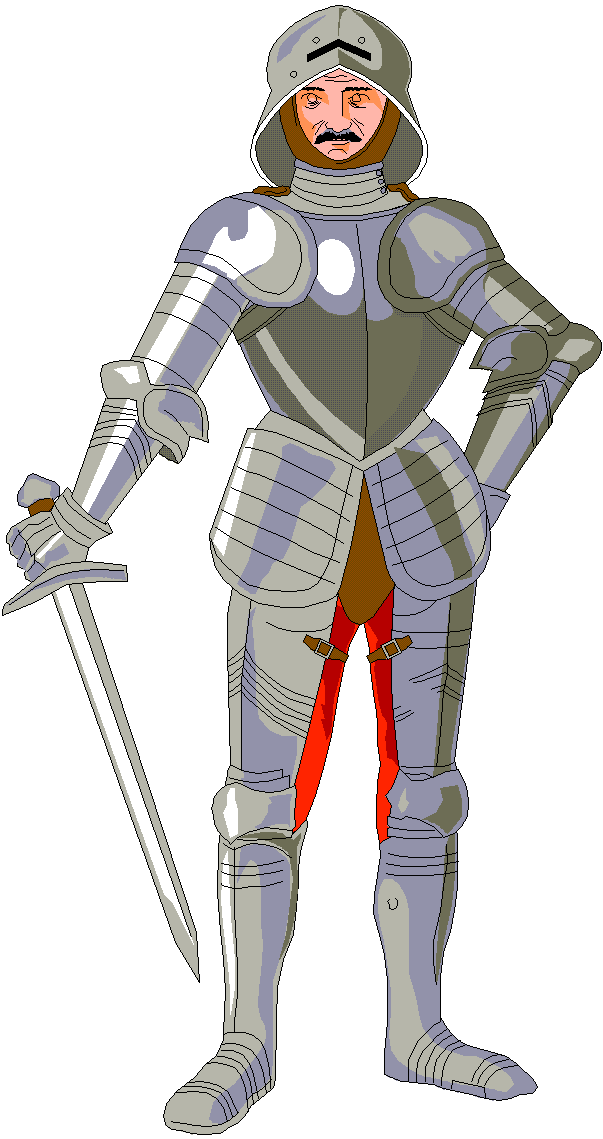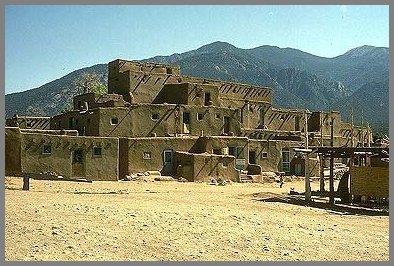 Another Stereotype of the Month entry:
Another Stereotype of the Month entry:
 Another Stereotype of the Month entry:
Another Stereotype of the Month entry:
From the Santa Fe New Mexican:
A legacy in stone
By JENNA NARANJO/The New Mexican
May 11, 2002
JEMEZ PUEBLO -- You could have heard a pin drop in Marie Baca's carpeted classroom the day she taught her students about Popé, an American Indian who is believed to have organized the Pueblo Revolt in 1680.
"They love hearing the history of the pueblos," said Baca, a Jemez Pueblo Day School teacher.
Baca's students were among nearly 300 people who gathered here Friday morning for a special ceremony to celebrate the arrival of a 7.5-ton chunk of Tennessee pink marble that Jemez Pueblo artist Cliff Fragua will transform into a statue of Popé.
Some believe the revolt for which Popé is famous helped preserve pueblo culture by driving out Spanish colonists from Northern New Mexico. The Spanish, however, were invited back in 1683.
When completed, Fragua's piece will be sent to the National Statuary Hall in the U.S Capitol in Washington, D.C.
"This occasion celebrates many firsts for New Mexico," Gov. Gary Johnson told the crowd gathered outside Fragua's Singing Stone Studio. Other state and tribal officials were also present.
Johnson told the audience Fragua will be the first American Indian to create a piece for the National Statuary Hall, and his statue will depict the oldest figure chronologically in the exhibit.
"The legacy of a man and a spirit of a stone has brought us together," Fragua told the crowd.
While the project -- a collaboration by state and tribal entities -- has faced various hurdles, including controversy and lack of funding, members of the state's Statuary Hall Commission said it is a relief to see the project being completed.
Commissioners hope to have the piece at the nation's capital by the end of the year. Fragua said he will have to work eight to 10 hours a day to complete the sculpture on time.
When the project was in the planning stages, some state residents and lawmakers said they did not want to send a statue of Popé, who was from what is now San Juan Pueblo, to the U.S. Capitol, reasoning he was a murderer and responsible for the deaths of thousands of Spanish settlers. Others question his very existence.
"I proposed a code-talker statue, which would have been much better and would have been historically accurate, precise and appropriate. The Popé story is none of those," said state Sen. Rod Adair, R-Roswell, who questioned the project when it was introduced to the Legislature in 1997.
"It would have been much easier to choose a hero and not an anti-hero," Adair said during a phone interview.
Commissioners argue the opposite.

"He was the first leader of the first American revolution," said commission member Marcia Keegan.
"This will be a lasting symbol of man's desire to be free," said Herman Agoyo, a commission member and president of the Popé Foundation, which is responsible for raising money to pay the estimated statue costs of $150,000 to $200,000. Agoyo said about $60,000 has been raised to date.
Agoyo, who initiated the project, said he decided more than 10 years ago that Pop should be represented in the statuary hall, where figures of historically notable, deceased citizens are on display. The Popé statue will be the state's second and final contribution.
The state's first submission depicts the late U.S. Sen. Dennis Chavez of New Mexico.
Speakers at the event said it will be an honor to have a Pueblo Indian depicted in the hall along with other leaders like Chavez.
"Popé is a hero," 9-year-old Nicolette Sandia said when asked whether she knew who Popé was.
"You cannot have a revolt where people aren't injured or even killed," said Fragua. "The significance of this revolt is that the pueblo culture survived and that the pueblo culture and ceremonies are still strong."
After the hour-long event, Fragua invited state and pueblo officials to use his chisel to break some of the first pieces off of the rectangular block.
"All of my journeys that I've gone through in my life have led me to this," Fragua said. "You could call it destiny if you like."
Name: Alfonso deHerera-Ulibarri
Date: May, 11 2002
Again the fairy tale about Pope comes up. This guy was no hero, especially to the Indians. He killed many of them during the revolt because they wanted to align with the Spanish. He was a murderer not only of the unprotected Spanish Colonists but also of his own people. We do not want a murderer standing along side a real man of the people like our revered Senator Dennis Chavez in Washington....Who made the decision that this guy should be sent to Washington? I certainly didn't vote on it. I certainly didn't have any say on it. Did any of you?
Rob's comment
I've read a couple dozen books on the Pueblos, most of them written by whites. No one has ever claimed Popé didn't exist or that he killed his own people. Nor has anyone claimed the Pueblos preferred Spanish rule to independence or that the colonists were "unprotected." It's the first time I've heard these unsubstantiated assertions.
As Fragua said, you can't have a revolt without killing people. From Crazy Horse, Sitting Bull, and Geronimo to Abraham Lincoln, Ulysses S. Grant, and Robert E. Lee, most great leaders have been responsible for deaths. The question isn't how many people died but whether their causes were just. Popé's cause was about as just as it gets.
The stereotype here is that someone "responsible for the deaths of thousands of Spanish settlers" is somehow unworthy of our honor. George Washington was responsible for the deaths of thousands of British soldiers (and Indians too). Christopher Columbus was responsible for the deaths of thousands if no millions of Indians. Yet few people question the honors these men have received.
Note the biased mindset of the New Mexican lawmakers. Popé was an outsider, one of "them," not a true American. The Spanish settlers were Europeans like "us," "our" ancestors, the people who built this "great nation."
Well, I, for one, don't feel any great sympathy for the Spanish settlers. They weren't my ancestors any more than the Pueblo Indians were. The so-called settlers were invaders who "settled" the land after conquering it by force. The Pueblo Indians who revolted were expressing the ideal of humankind everywhere: to be free of tyranny. That makes them and not the Spaniards the true Americans.


The story continues
Popé's place in N.M. history set in stone
By MARISSA STONE | The New Mexican March 4, 2005
The artist has chiseled away at a massive cube of marble for several years, churning up dust as he creates a 7-foot sculpture of Popé, the controversial American Indian leader of the Pueblo Revolt of 1680.
Clifford Fragua, a Jemez Pueblo artist who has been commissioned to create the artwork for the National Statuary Hall in the nation's Capitol, can't say how many hours have gone into the artwork.
"It's been carved over time," said the 49-year-old artist as he worked at a location he didn't want disclosed to protect the sculpture from possible vandals. "I work when I'm inspired — I get lost in time. I feel I'm not only carving stone but the spirit of Popé and the spirit of the ancestors and the spirit of everyone else in New Mexico who supports this project."
The 3.5-ton Tennessee marble sculpture will be unveiled at San Juan pueblo — where Popé was from — on May 21. The artwork, which is the last submission for the hall, will then be shipped to Washington , D.C.
Fragua, who began working on the sculpture nearly five years ago, has created something he believes Popé might have resembled. "There is no record of what he looked like," the artist said. "No drawings. I'm just capturing his image as the stone speaks to me."
Popé, a medicine man whose name means "ripe pumpkin," is said to have organized Indian tribes who were angered by the Spaniards' attempts to wipe out their religions and customs. The unified tribes joined forces and killed hundreds of priests and Spanish settlers before laying siege to Santa Fe and diverting its water supply.
The revolt temporarily freed Indians from oppressive Spanish rule and pushed 1,000 Spanish colonists to El Paso. The Spanish, however, came back to New Mexico in 1683.
"There have been many uprisings among native indigenous people to maintain their culture, but none had succeeded as much as this event," said former San Juan Gov. Herman Agoyo. "It was the only uprising able to drive a foreign power from Native lands in the history of the Americas."
"Our ceremonies still carry through from back then," said Fragua, whose sculpture wears a deerskin kilt and moccasins that resemble those worn in New Mexico pueblos today. "I imagine he wore that."
Agoyo — whom many credit with being the driving force behind Popé's selection as the state's second submission to the hall for New Mexico — looked over the sculpture recently with other tribal representatives.
"He was a great leader who fought for the rights of Indian people, so we could continue our way of life," said 76-yearold Benny Atencio of Santo Domingo Pueblo, the former vice chairman of the All Indian Pueblo Council.
A 1997 bill that state legislators passed — to create the Statuary Hall Commission — paved the way for the work to become a reality. The commission has since raised $200,000, from which the artist will receive $100,000.
Some detractors, many of them Hispanic, didn't like the idea of placing in the nation's Capitol the sculpture of someone they consider a murderer — a man about whom little was known. In 2001, a House of Representatives bill aimed at blocking the creation of the statue died.

Much of the history of Popé, also spelled Pop'ay , is oral, and many stories have been lost, Agoyo said. In the book Archaeologies of the Pueblo Revolt: Identity, Meaning, and Renewal in the Pueblo World, Agoyo wrote: "Among historians, there is much speculation on Popé's role in the Indian Pueblos' socio-political structure and religious life. It is likely, however, that he was a religious leader, because this would have given him access to the inner sanctuary of Taos Pueblo, from where he and other leaders planned the Great Pueblo Revolt of 1680."
Spanish historical records indicate Popé played a key role in planning the revolt, Agoyo wrote. On Dec. 18, 1681, a Tesuque Pueblo Indian named Juan testified under oath before Spanish colonial officials that "the chief mover and organizer of the revolt was a native of the Pueblo of San Juan, named El Popé ."
"Whether some people agree or not, that's our history," said Benny Shendo, secretary of the state Indian Affairs Department. But the statue of the late U.S. Sen. Dennis Chavez, a Hispanic and a Democrat, also graces the hall, he said. "These two worlds that clashed will be representing the state of New Mexico."
"Both the good and the bad is our history," Agoyo said.
"We'd have no statues in this country if we were looking for people who had offended no one," historian Marc Simmons has said.
Having Popé represent New Mexico at the hall is the culmination of years of work, Agoyo said. Since the celebration of the tricentennial of the Pueblo Revolt in 1980, Indians have slowly begun to know the significant impact the revolt had on helping Indians maintain their culture.
"If Popé and his contemporaries wouldn't have fought to protect what we had," Shendo said, "I don't know if we'd be standing here today."
More on the story
Popé did what others couldn't
Native Martin Luther King?
American Indian hero joins historical figures at Capitol
Honoring the man who led America's first revolution
Related links
Why write about the Hopi?
Those evil European invaders
This ain't no party: a Columbus Day rant
|
. . . |

|
All material © copyright its original owners, except where noted.
Original text and pictures © copyright 2007 by Robert Schmidt.
Copyrighted material is posted under the Fair Use provision of the Copyright Act,
which allows copying for nonprofit educational uses including criticism and commentary.
Comments sent to the publisher become the property of Blue Corn Comics
and may be used in other postings without permission.